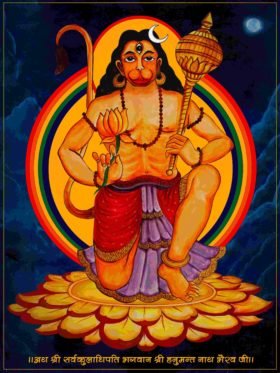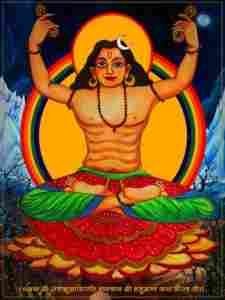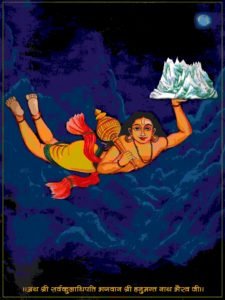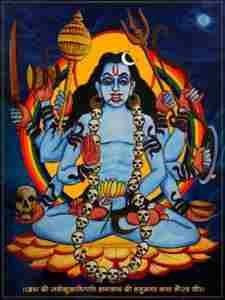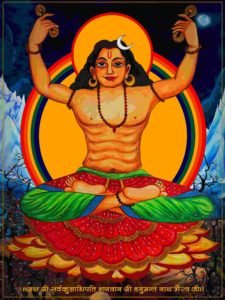Hanuman, is believed to be one of the most vibrant personality in Siddha Dharma. He is believed to be a deity who is a Mahayogi himself as he had mastered various forms of yoga like ‘Vajra Yoga’ and other forms of yoga. He is also a great tantric deity because he is also considered to be one of the ‘Ekadasha Rudra’. He is the master of all wisdom forms of Lord Shiva as he is Shiva himself but the society popularized him in the form of a ‘devotee’ with musical instrument in his hand and singing the paean of ‘Rama’. They also portray him as a monkey god but the ‘Siddha Dharma’ portrays him more like a Rishi/Muni in a human form. He took birth in the kulas of the monkeys but he had transformed himself to the status of a Mahasiddha. The ‘Siddha Dharma’ regards him more of a Mahasiddha then the monkey god and a bhakta.
He is also always referenced in association with Lord Rama as he is considered to be the greatest devotee of the Lord. Many sects and lineages of India believe him to be the epitome of ‘bhakti’ or devotion. As per ‘Siddha Dharma’, he is considered to be a mahachiranjivi i.e. immortal because he has won the death by some yogic technique and he also possesses the power to travel to other lokas.
The legend of the ‘Siddha Dharma’ says that he shall live in this world until the end of Kali Yuga, where he shall meet Lord Kalki and then he shall leave this loka. Also as per ‘Siddha Dharma’, he is believed to be present in this world to guide the society towards light in the darkness of kali yuga.
Etymology and nomenclature
The word Hanuman, etymologically means (hanu+mant), ‘hanu’ means jaw and ‘man’ means broken. He got his name as Hanuman because he broke his jaw when Indra attacked him with his vajra and then he fell down and broke his jaw. There are many interpretations of his name. Not all have the same interpretation and meaning. But the most undisputed fact is that his initial name was Maruti which literally means the son of Maruta (Vayu God).
As per ‘Siddha Dharma’, he is known as Hanuman because ‘Hanu’ means ‘hana’ or subdue and ‘mana’ means ‘ego’. He is believed to have subdued his ego to such extent in bhakti that though he is a ‘Maha Vajrangbali’ and very powerful deity, he still has no ego. He is a powerful deity symbolizing absence of ego.
As per ‘Siddha Dharma’, his biological parents were Kesari and Anjani. His mother is believed to be a cursed celestial nymph “Punjika”. The ‘Vayu God’ also known as “Maruta” is believed to be his divine heavenly father. He is also known by the name as “Vajrangbali” which literally interprets as (vajra + anga + bali) where vajra is ultra solid, anga means body parts and bali means powerful. The synthesis of the three words implies that ‘Vajrangbali’ is a deity who has a rock solid body parts and who is the most powerful among the powerful.
He is also known by the name “Anjaneya” which means the son of Anjani.
DIFFERENT FORMS OF HANUMAN
Tantric Hanuman
As per ‘Siddha Dharma’, Hanuman is considered to be a Mahasiddha because he is considered to be one of the ‘Ekadasha Rudra’. Being Rudra himself, he is someone who has perfected all forms of available tantra of Lord Shiva. ‘Siddha Dharma’ being a very secretive dharma has always worshiped Hanuman very secretively and in tantric way. It was only after the infusion of ‘Bhakti Revolution’ in the Indian sub-continent, the ‘tantric hanuman worship’ began to diminish and his ‘monkey form’ became more prevalent in the society. The ‘tantric’ element was subtracted from Hanuman and he was converted into a deity epitomizing bhakti.
Based on the legends of ‘Siddha Dharma’, tantric Hanuman is considered to be the deity who is the dispeller of all evil spirits and all obstacles of life. His worship is done with the help of ‘yantra’. Furthermore, his symbolic representation of flag was used in the protection of chariot of Arjuna in Mahabharata. The power of Hanuman was invoked in the flag and it was placed on the top of the chariot. It was placed for the protection of the chariot and also Arjuna. His flag also symbolizes ‘Dharma’. It is also called as “Dharma Dhwaja”.
As per ‘Siddha Dharma’, Hanuman ji is also called ‘tantreshwara’ because he was taught all the tantras by Lord Shiva in Mount Kailasha.
Vajra Yogi Hanuman
The ‘Siddha Dharma’ believes that Hanuman ji is also a Mahayogi. He had perfected various forms of yoga for the perfection of his body and also the perfection of yoga. The ‘Siddha Dharma’ believes that Hanuman ji is referred to as ‘Vajrangbali’ because he had perfected the vajra yoga and made his body as hard as a vajra scepter, the weapon of Indra. He is also believed to have perfected the ‘Vajroli Mudra’ for the perfection of celibacy.
Based on the legends of ‘Siddha Dharma’, there are two stories explaining Hanuman ji to be a vajra yogi and both the story is related to “Lord Surya”. According the first story, one day when Hanuman ji as a kid became very hungry and he wanted to eat something big. He then saw the sun shining high in the sky. Out of inquisitiveness, he marched towards the sky to swallow it. Indra having witnessed this incident tried every power of his to stop Hanuman from reaching Lord Surya and Hanuman defied all his powers. Indra then attacked him with his ultimate weapon, his vajra made from the body of Maharishi Dadhichi which struck Hanuman and then he fell down to the ground and remained unconscious.
His divine heavenly father Maruta, the vayu god became very furious and he then stopped all the vayus from flowing. This caused the whole planet to suffocate and then slowly the living organisms started to die. Seeing this, all the gods along with Prajapati requested Maruta to take back his vows. When he took back his vows, the gods then started to give various boons to Hanuman and among the boons were that he would not be destroyed by vajra as he would have a body of a vajra and in future his body could withstand even the vajra of Lord Indra. Because of the boon, he was then called as “Vajrangabali’.
The second story is more popular in ‘Siddha Dharma’. As per them, when Hanuman wanted to eat the sun god, he marched towards the sun god. He then trespassed all the heat and fire of the sun god. He then approached such near to the sun god that the sun god became very pleased with Hanuman and asked him about his identity. Hanuman then introduced himself to the sun god. The sun god then became pleased and asked Hanuman to ask for any boon. Hanuman the ultimate epitome of wisdom, asked the sun god to bestow him knowledge. Lord Surya or the sun god then became his guru and imparted him all his wisdoms to him.
Out of all the wisdoms that Lord Surya imparted to his disciple Hanuman, he imparted ‘Vajra Yoga’ to Hanuman. ‘Vajra Yoga’ is a special type of yoga that specializes in the use of ‘vajra nadi’ for the perfection of human body, mind and the soul. It is also the perfection of yoga through vajra nadi. Vajra nadi is also known as sub-nadi of ‘surya nadi’. Lord Surya was such impressed with Hanuman that he imparted him the ‘Vajra Yoga’ through which Hanuman would be able to perfect the ‘Guru Tatwa’ inside him and also perfect the vajra nadi. Later, Hanuman perfected the ‘Vajra Yoga’ and his body became vajra like and then he was referred to as “Vajrangabali”.
Lesser known fact to the public is that Hanuman ji got his name as ‘Vajrangabali’ from “Vajra Yoga”. The society has only portrayed him something that is far beyond his real capabilities and his character traits.
Bhakti Yogi Hanuman
The most popular form of Hanuman ji in the public domain is his form that depicts bhakti. He is depicted as holding some musical instrument and then chanting ‘Rama’ continuously. The form depicted is greatly inspired by the ‘bhakti movement’. They further depicted Hanuman ji as per their understanding of him and not as per the objective truth.
The ‘Siddha Dharma’ view is different to those of the society and particularly the ‘bhakti movement’ inspired literature and depiction of Hanuman ji. The ‘Siddha Dharma’ believes that the bhakti or devotion of Hanuman ji was not physical but metaphysical. He was not just the devotee of physical Raghuram and he didn’t perform his bhakti based on it. Instead Hanuman ji was more metaphysical and transcendental when it came to bhakti or devotion. He was devoted to ‘Rama’ and Rama is the ultimate supreme lord who resides in the hearts of every human. Shree Raghunath ji, was an avatara as he had cultivated ‘Ishwarata’ inside him. Hanuman ji was more devoted to the metaphysical Ishwara then the physical personified Ishwara. Had he been attached to the personified Ishwara, the death of the body of Shree Raghunath Rama would have ended the bhakti of Hanuman ji but he being the devoted, he is believed to be in this earth waiting for the avatara of Mahabhagawan Kalki. Like Raghunath Rama, Kalki would also cultivate the ‘Ishwaratwa’ in him and it is that ‘Ishwaratwa’ that Hanuman ji is waiting to have a glimpse in the dark kali yuga phase.
The second interpretation of Hanuman ji can also be understood from the authentic bhakti yoga perception. The ‘Siddha Dharma’ believes him to have mastered two systems of bhakti i.e. ‘saguna bhakti’ and ‘nirguna bhakti’. The ‘saguna bhakti’ of the Lord Raghunath Rama and the nirguna bhakti of Ishwara post Lord Raghunath Rama.
The ‘saguna bhakti’ of Hanuman ji is the most misinterpreted form of bhakti. The ‘saguna bhakti’ as per ‘Siddha Dharma’ is believed to be a very simplistic yet most sophisticated concept. The ‘Siddha Dharma’ believes that when a supreme Ishwara descends into a human body then the body is also bound by the rules of the material world. He/She is subjected to pain and pleasure, heat and cold like a normal human but the main element in him or her remains the element of the Ishwara. Therefore, an avatara is a simple person with ‘Ishwaratwa’ in him. Nobody can ever differentiate an avatara with a normal human because the concept of avatara is more ‘metaphyscial’ then ‘physical’. The avatara is a subtle concept based on metaphysical understanding of reality. Had an avatara been physical, the constant change of the bodily form would also have increased and decreased the magnitude and vector of the avatara. Hanuman ji understood this aspect of reality, therefore whenever he saw Lord Raghunath Rama, crying for his brother and heartbroken for his consort Sita, his devotion never decreased with his subjective view of Lord Raghunath Rama’s actions. He didn’t perceive Lord Raghunath Rama as an ‘anamaya kosha’, ‘pranamaya kosha’, ‘manomaya kosha’, ‘vigyanamaya kosha’ nor ‘anandamaya kosha’. He perceived Rama beyond all the koshas. For him, Rama transcended all the material truth and all the five koshas of the human body.
Hanuman ji had such subtle understanding of ‘Rama’ that he perceived Rama as it is and not what his senses, intellect, mind inferred. He viewed and ultimately understood Rama exactly as it is and based on objective reality and less of a subjective truth. Therefore, the ‘Siddha Dharma’ believes Hanuman had perfected ‘bhakti yoga’ and he is also a deity who has truly understood the ‘Ishwara’ so he is regarded as the epitome of ‘bhakti’ by the ‘Siddha Dharma’.
Relationship with Bhagawan Kalki
As per the ‘Siddha Dharma’, Hanuman ji is a Mahasiddha who had perfected numerous oriental wisdoms. It is a less known concept among the public that Hanuman ji also is one of the ‘Ekadasha Rudra’. ‘Rudra’ in tantra is also referred to as ‘Isha’ and ‘Isha’ means ‘Ishwara’. Hanuman ji is an Ishwara in himself. He is such a secretive and mayawi person that for the world he seems to be someone who is in the state of duality with Ishwara or in clear terms, separation with Ishwara. Lesser known fact is that he was an Ishwara in himself and he served the Ishwara in Lord Rama and being an Ishwara in himself, he would also wait till the dark phase of ‘Kali Yuga’ to witness the ‘Ishwara’ in Lord Kalki. He is in the state of pure adwaita or non dual state of bhakti because it is the Ishwara searching for Ishwara, serving the Ishwara, waiting for the Ishwara and then ultimately being one with the ultimate Ishwara. Such refined and depth is his bhakti that the humans have only depicted him as a deity who is separated from Ishwara but the ‘Siddha Dharma’ believes that he never was separated, all he did was perform the divine play of separation.
He is believed to be in the wait for Lord Kalki to take an avatara. The ‘Siddha Dharma’ believes that he was directed by Lord Raghunath Rama to be a mahachiranjivi for two purposes. The first for the protection of Maha Vaishno Devi till the dark phase of kali yuga and secondly to witness the complete avatara of the Ishwara. The ‘Siddha Dharma’ believes that Lord Kalki would be the complete incarnation of Ishwara. He would personify all the sixty four art forms of the Ishwara. After witnessing the final complete avatara of Ishwara, Hanuman ji would permanently leave the earth and then would ultimately be one with the Ishwara.
Furthermore, he is also believed to protect the devotees in kali yuga against injustice. He is the protector and savior for all the devotees who truly are astika.
‘Vajra Yoga’ and ‘Vajra Hanumant Diksha’ in Siddhachara.
As per the ‘Siddha Dharma’, Siddhachara is a tantric kula which predominantly uses rituals, yoga, ayurveda etc for the worship of particular forms to achieve a particular resolution. The ‘Siddha Dharma’ mainly in its worship module uses the amalgamation of tantra and yoga to achieve a particular purpose.
The ‘Vajra Hanumant Diksha’ is the upcoming sadhana camp going to be held in Satara, Maharastra in the ending weeks of November, 2018. The ‘Vajra Hanumant Diksha’ is the diksha related to the form of ‘Vajra Hanumant’. Here, based on ‘Siddhachara’, the ‘Vajra Yogi’ form of Hanumant is going to be worshipped with the help of vast ‘Siddhachara’ i.e. through the use of rituals and also through yoga. In short, his yogic form of ‘Vajra Hanumant’ is worshipped and perfected through the help of rituals.
Furthermore, the ‘Vajra Hanumant Diksha’ as based on ‘Siddhachara’ is always going to use ‘avarana puja’ for its worship module. The ‘avaran puja’ is the worship of the veil behind which every deity hides. Just like an orange seed hides in the peels and flesh of the orange fruit, the deity always hides behind various layers and filters of maya. Only when one lifts the entire veil then the deity is truly known. In tantra, the Shiv is always behind the veil of various layers and it is through the help of the shakti, the veil is lifted and the real Purusha (Shiv) behind the veil of Prakriti (Maya) is known.
As per ‘Siddha Dharma’, the shakti of Hanuman ji is Suvarchala. He is also believed to have a son with her named Makardhwaja. Therefore, in the worship of ‘Vajra Hanuman’, his shakti ‘Suvarchala’ is specially worshiped so that the ‘Vajra Hanumant’ hiding behind different veils is then realized and known.
Purpose of “Vajra Hanumant Diksha”
As per the ‘Siddha Dharma’, Hanuman ji is the master of ‘Vajra Yoga’ or ‘Vajrayana’. Vajra means ultra rock solid. Vajrangbali also means that all his body parts are as strong as the ultra rock solid vajra and he is also the most powerful among the powerful. Lesser known fact is that, Hanuman ji is vajra from both inside and outside.
Basically, ‘Vajra Yoga’ makes the body of the practitioner ultra rock solid like vajra. As per the ‘Siddha Dharma’, we have five different bodies inside us and they are ‘anamaya kosha, pranamaya kosha, manomaya kosha, vigyanamaya kosha and anandamaya kosha’. Therefore, the ‘Vajra Yoga’ not only makes the outer body i.e. anamaya kosha like a vajra but also the prana body, the mind body, thought body and ultimately the bliss body.’
The perfection of ‘Vajra Hanumant Diksha’ makes all the bodies mentioned above very strong like that of Hanuman. Hanuman ji had a vajra sarira i.e. vajra anamaya kosha, vajra prana body through which he was able to strengthen all the inner pranas, vajra manamaya kosha where he perfected bhakti and also very strong in his resolutions, vajra vigyanamaya kosha i.e he perfected astasiddhis as he could elongate or shrink his body as per his will and his thoughts and ultimately the vajra anandamayi kosha where he was always in deep ananda or bliss of bhakti.
Furthermore, for a novice sadhaka, the ‘Vajra Hanumant’ worship is about making mind and intellect along with the body, like a vajra. The sadhaka then has a strong body and as well as his virtues like vrata (vows), sankalpa (resolution) is strengthened to such peaks that they do not flicker in difficulties as their vows and resolution also becomes like a vajra.
The ‘Vajra Hanumant’ worship makes the body, mind, resolution, vows etc of the sadhaka like a vajra and they can overcome any obstacles in life because the vajra element provides them clarity and firmness in whatever they pursue.
Relationship with Ma Vaishno
As per ‘Siddha Dharma’, there is a legend of Lord Rama and the meeting of Ma Vaishno in Ramayana. According to the legend, when Ma Vaishno meets Lord Rama while he was at exile, she recognizes him and she proposes marriage with him. Since, Lord Rama was the personification of Ishwara in the form of ‘Maryada Purshottama’ or ‘adherence to strict duties’, he indirectly rejected her offer because he was a committed husband and the action would set a bad precedent to the society. Ma Vaishno also had the element of shakti in her so it would have been a great insult to reject the shakti in her. Lord Rama because of complications of the situation promised that he had to reject her and he could only marry her in his next birth as ‘Kalki Avatara’. Ma Vaishno realizing the depth and complication of the situation accepted it and then she also decided that she would wait till the dark phase of kali yuga to meet ‘Kalki Avatara’ and marry him and then she has been in the wait for the ‘Kalki Avatara’ to descend and marry her. The greatest irony of the marriage is that it would be a ‘Gandharva Marriage’ and the marriage ceremony would not last more than few hours. She would then leave this earth while Lord Kalki would then carry out his mission in this earth.
Lord Rama explicitly directed Hanuman to be her protector till the kali yuga and he was then bestowed with the boon of immortality by Lord Rama for the protection of Ma Vaishno. The ‘Siddha Dharma’ believes that Hanuman is in this earth foremostly for protecting Ma Vaishno and secondly also to direct the future sadhaks in the path of Ishwara. The ‘Siddha Dharma’ treats Hanuman ji as a ‘Gurumandala’ and he is also a guru who constantly guides sadhaks into the path of Ishwara.
Modern day worship
The modern day Hanuman worship has been greatly influenced by the bhakti movement. He is depicted more as a bhakta separated from his bhagawan then greater prowess like ‘Vajra Yogi’, ‘Tantric Hanuman’ etc. He is depicted as a monkey god who is engrossed in deep bhakti with the feeling of separation with his lord. Furthermore, after the inception of Tulsidasa Ramayana, the ‘Hanuman Chalisa’ came into existence. The ‘Hanuman Chalisa’ is a hymn of Hanuman ji which consists of forty couplets eulogizing and praising him. The daily recitation of ‘Hanuman Chalisa’ is the most famous worship module of Hanuman ji in modern day. But the ‘Siddha Dharma’ has a different view on modern day worship of Hanuman ji.
The ‘Siddha Dharma’ believes that Hanuman ji is the most active deity in ‘Kali Yuga’. He is an active Guru among the ‘Gurumandala’. He still guides sadhaks into the path of Ishwara in the form of Guru. He is also believed to be the dispeller of all fears and black magics. He is also a ‘Vajra Yogi’ so he is worshipped in the form of ‘Vajra Hanumant’. The ‘Siddha Dharma’ outlays different modules for the worship of different forms of Hanuman. He can be worshipped through yoga and also through tantra.
He is mainly worshipped in ‘Siddha Dharma’ in the form of Hanumant based on pure tantra but the ‘Vajra Hanumant’ diksha is a mixed worship module of Hanuman ji, where he is worshipped through both tantra and yoga. Both modules are based on the vajra nadi and vajra nadi can be perfected through both tantra and yoga. The ‘Siddha Dharma’ also prescribes worship module of his ‘Dusbhuja Hanuman’ form meaning Hanuman ji with 10 hands.
Basically, Hanuman ji worship in modern day as per ‘Siddha Dharma’ is not only about perfecting bhakti but also perfecting various tantras and yoga. Through the worship of Hanuman ji, ‘Vajrayana’ as well as ‘Vajra Yoga’ can be perfected.
Ishaputra and Hanuman ji
His Holiness Mahasiddha Ishaputra, the head of the ‘Siddha Dharma has always regarded Hanuman ji worship very highly. Infact he has already conducted ‘Hanumant Diksha’ camp before and the next camp to be held is the ‘Vajra Hanumant Diksha’ due to be held in the ending weeks of November, 2018. He regards ‘Hanumant Diksha’ very highly because the Hanuman ji is the perfect role model for all the sadhaks who wants to become something in the path of adhyatma. With the blessing of Hanuman ji, a sadhaka can master all forms of tantra of Lord Shiva as well as various yogas like ‘Vajra Yoga’ etc. Hanuman ji also inspires a sadhaka to become ‘astika’, the believer of existence of ultimate god.
As per the ‘Siddha Dharma’, Hanuman ji has always protected Ishaputra at the time of his sadhana. When he used to go to the Himalaya for the practice of his sadhana, it was Hanuman ji who used to protect him against all the wild animals and various obstacles. Mahasiddha Ishaputra became the head of ‘Kaulantak Peeth’ with the constant supervision of Hanuman ji in his sadhana period. The ‘Siddha Dharma’ therefore regards Hanuman ji very highly and prescribes the worship of Hanuman to his disciples in the Guru/Sishya tradition.
Curse of Hanuman
As per the Siddha Dharma, Hanuman was not immune to curses. He had been cursed as a child for disturbing the lifestyle of Rishi/Munis. He as a kid used to disturb the Rishi/Munis from their penances. He was cursed by a Rishi that he would forget all his valor and strength and become a common person. Later, he forgets his strength and then Jambavanta later reminds him of his strength and valor. When he is reminded about his powers, he then realizes his powers and becomes as powerful as before.
The ‘Siddha Dharma’ uses this story to teach its sadhaka that we are all by nature Hanuman ji. We are all powerful beings but we have forgotten our real powers. The day when someone realizes us of our powers like Jambavanta reminded Hanuman, we shall again become like Hanuman ji. Every Guru reminds their disciples that the disciples are Hanuman ji through the use of diksha and when the sadhaka perfects the diksha, he like Hanuman ji becomes again realizes his full potential.
Iconography
As per ‘Siddha Dharma’, there are many depictions of Hanuman ji. The most famous form that is prevalent in the society and in ‘Siddha Dharma’ is Hanuman ji ni ‘Veerasana’. Hanuman ji is portrayed as deity who holds a lotus flower in his one hand and in the other, he holds a mace. This particular pose of Hanuman ji is also called as ‘Veer Hanumant Asana’.
He holds a lotus flower in one hand which symbolizes prosperity, wealth and abundance. At the other hand he carries a maze. The maze is the symbol of strength.
In the yogic form of Hanuman, he is potrayed as a simple yogi in siddhasana or padmasana with gyana mudra. In ‘Dusbhuja Hanuman” form, he is depicted with ten hands and it is his wrathful form. He is depicted as wearing the garland of skull cap and holding weapons. He holds trishula, bow, shield and skull cap in his right hand and a mace, damaru, sword and a skull in another hand. He is also depicted with a third eye as shown in the picture.
Hanuman ji is invoked in his flag and placed in places for its protection. His flag is like the flag of Nepal, two triangles conjoined and in the midst of it, hanuman ji is depicted as carrying the Dronagiri hill with him and flying towards Lanka.
There are also other forms of Hanuman ji where he is depicted sitting on padmasana and then ripping his chest. In the original Ramayana, Hanuman ji had ripped his chest to prove to the world that the lord Rama and Sita resides in his heart.

